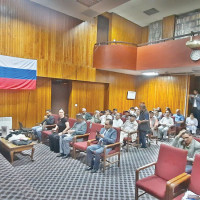- Monday, 20 October 2025
Birds Coexisting With Humans
Globally, wildlife is adapting to the challenges caused by human activities. In the photograph, a cattle egret (Bubulcus ibis) approaches the woman intensely, taking a risk to catch disturbed insects from her movements. The observed behaviour shows how birds struggle to survive in urban areas affected by human activity.
The intended pest-eliminating chemicals named herbicides, insecticides, and pesticides used throughout urban and agricultural zones severely disrupt natural ecological systems. And they have caused a significant reduction in insect populations, which represents the main food source for many birds. The scarcity of natural insect-based feeding opportunities affects birds that normally feed on insects for survival. The birds find survival through new feeding practices because they follow both humans and herd animals that break surface cover to reveal prey. The egret showed major changes in its survival strategies through this observed behaviour.
The birds normally conduct their native hunts in wetlands by feeding primarily on fish and amphibians along with insects. The shrinking wetlands have compelled these birds to develop different ways for food procurement. When egret birds follow human groups on agricultural grounds, they enhance their prey opportunities yet expose themselves to possible negative human interactions.
Recently, a team of researchers visited the Nala region in Banepa Municipality to study the plant diversity in the forests and agricultural lands. It was observed that there has been rampant use of herbicides, insecticides, and pesticides in the farmland for achieving maximum yield on potatoes and crops. The 1600–1800-meter elevation of this area could potentially generate favourable conditions for rich biodiversity, although the region showed very low/no insect population.
There are almost no insects present in this area since butterflies, grasshoppers, dragonflies, and other flying pests have vanished entirely, thus making food scarce for birds and insectivores. Multiple chemical contaminations cause complete insect extinction that directly results from excessive pesticide utilisation, thereby disrupting the entire ecosystem framework. The survival struggle of birds leads them to exploit human-created activities for finding food, which demonstrates an essential transformation in the natural-human wildlife connection.
Birds in their natural state keep their distance from people because they consider humans to be possible dangers. The pace of our urbanisation has led various urban and semi-urban areas to experience increased acceptance among bird species toward human contact. Numerous bird species, including pigeons and crows along with egrets, now inhabit human dwellings to find food due to a transformation in their behavioural patterns.
The growing need for sustenance through human activities changes fundamental patterns between wildlife and humans. The combination of essential need and adaptation experience serves as the main cause for this behaviour change. The decline of natural food resources drives birds toward human settlements, thus creating a situation of necessity. When birds face repeated encounters with humans during safe encounters, they develop reduced responses of fear. Human-wildlife interactions gradually become more intense because of this process, yet these encounters frequently disrupt natural ecological systems. The adaptation of birds to human settlements demonstrates their capacity to survive but reveals significant signs that nature needs restoration.
Excessive use of pesticides along with urban development has resulted in population declines of insects while wiping away nesting sites and disrupting bird migration routes and interfering with species reproductive capabilities. The closer proximity of birds to human-built spaces exposes them to three major threats, which consist of motor vehicle danger as well as pollution effects and predation from household pets, including cats and dogs.
The total reliance on foods provided by humans creates uncertainties about eventual species survival. The survival of birds could become uncertain when human activities that provide their food sources experience change or disappearance since they depend on these activities at high rates. Birds that lose their natural foraging patterns because of human interference become less fit and less adaptable to environmental changes, which makes them more defenceless against natural environmental shifts.
The dependence of birds on human activity requires immediate action for natural ecosystem conservation. Ecologically responsible farming practices, which decrease harmful chemical intake along with protective measures for green and wetland areas, permit insect survival, enabling birds to feed on their natural prey.
Cities require biodiversity-friendly urban planning with implemented bird-friendly gardens among its designs while protecting existing natural spaces within their boundaries. The understanding of environmental issues among the public forms a crucial requirement to minimise harmful impacts against wildlife stemming from human activities.
The recognition of pesticide harms increased at the same time as people worked to expand biodiversity through organic agriculture and animal habitat reconstruction for stable ecological systems.
While a woman was cutting grass, a bird maintained tight proximity above her, as this moment serves as proof that animals remain active due to their capability to adapt under human-created difficulties.
The adjustment of birds towards controlling dangerous machinery serves only as a short-term option for their survival in an environment where habitats degrade rapidly.
Wildlife needs the elimination of habitat destruction combined with coexistence strategies to continue thriving freely in their natural habitats rather than putting themselves at risk through survival behaviour. Wildlife now unintentionally joins the human-modified environment as it evolves survival mechanisms that yield brief food sources while revealing the broad impacts of human settlements.
Permanent ecosystem destruction caused by the combination of human-caused stressors and lacking natural habitat conservation initiatives leads to biodiversity reduction. The continued existence of urban wildlife together with human care for nature establishes essential requirements for maintaining health in ecosystems.
Adequate protection of agrobiodiversity requires proper regulations that back sustainable agricultural procedures through international agreements and treaties to limit insecticide, herbicide, and pesticide overuse.
The Stockholm Convention on Persistent Organic Pollutants (POPs) requires all nations to ban hazardous pesticides that endanger biodiversity. Both the Rotterdam Convention facilitates coordinated chemical trade responsibility among countries to prevent uncontrolled pesticide utilisation, and the Stockholm Convention works for poisoning chemical elimination and controls.
The Convention on Biological Diversity (CBD) has established the requirement to decrease agricultural pollutants that degrade ecosystems while destroying biodiversity. Protecting wildlife health and human well-being needs three fundamental elements, which consist of integrated pest management (IPM) strategies, organic farming practices, and awareness programmes about chemical persistency.
International guidelines acquisition involves government partnership with agricultural stakeholders and policymakers to execute sustainable implementation of methods that protect the environment above short-term harvest improvements.
(The author is a plant ecologist at Tribhuvan University.)

















